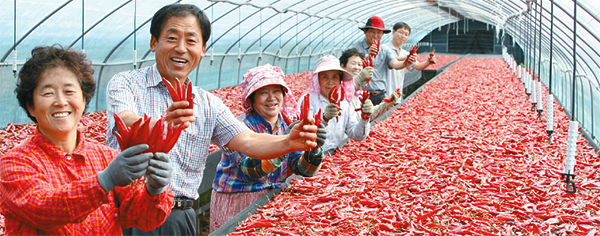Pepper farmers rake it in as crop yields go red hot

Farmers in Yeongyang, North Gyeongsang, hold up harvested red peppers on Sept. 26. Despite its low fiscal self-reliance ratio of 9 percent, Yeongyang County reported sales of 100 billion won (89.4 million dollar) last year from red pepper products harvested in the region. By Gong Jeong-sik
It may be easy to assume people residing in Yeongyang County, North Gyeongsang, are under financial strain since the county’s fiscal self-reliance ratio is only 9 percent, ranking it 224 out of 228 among local governments for fiscal soundness.
Farmers’ earning levels in the county, however, are in the top bracket thanks to its giant red pepper fields that generate the largest pepper production in the country.
“This year’s harvest has been successful thanks to avoiding three typhoons that hit elsewhere in the country,” said Lee Dong-ho, a farmer for 35 years. “But prices are lower than last year, maybe because of a boost in supply.”
Lee has generated around 300 million won ($268,000) in sales this year from his 42,000-square-meter (10.3-acre) farm, producing around 10.8 metric tons (23,809 pounds) of red peppers.
Among 90 households in the town of Jeongjok-ri, over 20 farming families have earned over 100 million won in sales.
Though it is true that farmers have to endure back-breaking labor to farm peppers, many of the residents in the countryside town also own apartments in big cities such as Seoul and Daegu.
“I do feel pain in my back from bending all day long to pick up peppers, but it is the pepper farming that paid for the education of my kids as well as my general living expenses,” said 56-year-old female farmer Kwon Sok-hee.
Kwon has been picking peppers from 6 a.m. until the evening as she has to finish this year’s harvest year before it freezes, which usually happens between late September and early October.
There are around 400 rural households in Yeongyang that reported their farm product sales exceeding 100 million won. Of the 400, over 300 farm families grow red peppers, with some making up to 500 million won.
The wide temperature range in a day in the region is considered to make red peppers from Yeongyang special as the change in temperature makes peppers sweeter and hotter.
Another factor that led to the successful farming story of the county is the establishment of the Yeongyang Distribution Corporation, which buys pepper products directly from farmers with the minimum price set at 2,200 won per kilogram ($0.89 per pound).
The absence of middlemen in the process of buying and selling thanks to the direct distribution center has guaranteed high profits for farmers when harvest production is high.
“The distribution center virtually sets the country’s price range for red peppers as the center directly deals with farmers in Yeongyang County, which is the nation’s biggest pepper production region,” said Gwon Jeong-rak, who works at the county office.
The county’s efforts to generate more profits did not stop at only setting up the distribution center. Since 2007, the county has hosted an event in Seoul Plaza in front of City Hall in a bid to advertise and sell red peppers produced in Yeongyang to people in Seoul. This year, the county sold around 4 billion won worth of peppers during the three-day event.
In an effort to maximize benefits stemming from the red pepper industry, the North Gyeongsang Provincial Government also started running the employment training center this year to supply labor for the pepper harvest activities in the county.
“After we streamlined the product distribution process for red peppers by setting up the direct center, we saw a spike in profits from harvests,” said County Gov. Kwon Yeong-taek.
Yeongyang County has reported around 100 billion won in sales of red peppers last year, which is double the sales recorded six years ago. The 100 billion won worth of sales is what Governor Kwon claims to be the country’s only case of farmers reaching that figure with a single product.
“We are planning to set up more red pepper related facilities such as a factory to produce red pepper sauce to create more benefits from the industry,” Kwon added.
By Song Yee-ho [jkkang2@joongang.co.kr]










with the Korea JoongAng Daily
To write comments, please log in to one of the accounts.
Standards Board Policy (0/250자)